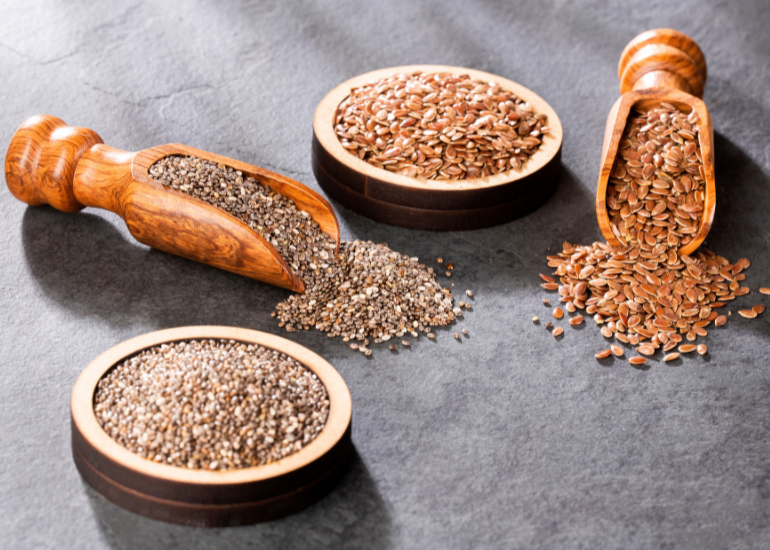If you’re looking for ways to improve your health, chances are high you’ve come across flax and chia seeds. Native to Mexico and Guatemala, chia seeds were consumed thousands of years ago. Flax is grown in more than 50 countries and is seen as a tool to prevent diseases and boost health. These nutrient-rich seeds are versatile, filled with fiber and can be added to a variety of recipes.
Continue reading to learn more about the benefits of flax vs chia, as well as how to use flax and chia seeds in your daily routine!
You might be wondering: is flaxseed better than chia? The reality is both seeds offer various health benefits, from fiber to omega-3 fatty acids.
Chia seeds can be used in a number of ways, with many chia seed recipes available, such as chia water and chia pudding. There isn’t a best way to each chia seeds; the recipe options are endless and delicious!
Flax can also be added to a variety of foods—from smoothies to oatmeal.
Nutritional Breakdown: Flaxseed vs Chia Seed
When doing a nutrient comparison of chia vs flax, it’s clear that both offer some of the same nutrients, just in different amounts. Navitas Organics Chia Seeds provide 9 grams of fiber per 2.5 tablespoon serving, proving that they are high-fiber seeds. The protein content in chia vs flax differs, however, with chia containing 5 grams per serving and flax providing only 2 grams.
Two tablespoons of ground flax contain 4 grams of fiber in addition to lignans, which are bioactive components that could help prevent cancer.
Chia and flax are vegan omega-3 foods. Although both options are plant-based omega-3 sources, the omega-3 in chia vs flax differs, with chia seeds providing more fatty acids. Alpha-linoleic acid (ALA) makes up the majority of chia’s omega-3 content.
Flaxseed can be milled, ground or pulverized, which makes ALA more bioavailable to the body.
Micronutrients and Antioxidant Levels
A super seeds comparison of flaxseed vs chia seed shows that both offer various micronutrients and antioxidants to benefit your health.
Chia seeds contain several amino acids including arginine, leucine and phenylalanine. In addition, phosphorus, calcium, potassium and magnesium boast the highest levels of all the minerals found in chia seeds.
Research has also shown that chia seeds contain vitamins B1, B2 and niacin. Polyphenols, which are plant compounds, and tocopherols, which act as antioxidants, are present in chia seeds as well.
Flaxseed is a source of antioxidants too, including tocopherols, beta carotene, phytosterols, polyphenols and flavonoids.
Health Benefits of Chia and Flax
With the variety of micronutrients and antioxidants found in these two seeds, it makes sense that they would provide several health benefits.
A meta-analysis of several studies found that chia seed supplementation resulted in a significant reduction in C-reactive protein, waist circumference and systolic blood pressure.
Flaxseed has been shown to reduce the size of tumors in women with breast cancer in a review of ten studies. Research has shown that flaxseed health benefits include a reduction in blood pressure as well as a decreased risk of having high blood lipids and obesity.
Heart Health, Digestion & Weight Management
Many studies have been done to better understand these seeds’ roles in heart health, digestion and weight.
A study looking at the effect of flaxseed on blood lipid levels was done where participants received cookies with ten grams of either psyllium fiber or flaxseed, or cookies with nothing added. Participants who received flaxseed for 12 weeks had lower total cholesterol, LDL cholesterol and triglyceride levels, while HDL (“good”) cholesterol increased. After the participants stopped eating the flaxseed for four weeks, their total cholesterol and LDL cholesterol levels were significantly elevated.
Flaxseed also helps prevent constipation, improves stool consistency and has been shown to benefit gut microbiota.
However, the fact that chia seeds contain more fiber than flax does suggests chia are the best seeds for gut health.
A review article compared various studies to better understand the relationship between dietary fiber and weight. While the overall consensus was that more research is needed to study stronger associations between the two factors, some studies included in the review suggested that fiber intake could be a likely solution to overweight and obesity.
Because of the fiber content on chia seeds and flax, it’s possible that they are healthy seeds for weight loss. However, seeing as chia seeds contain more fiber, when comparing chia vs flaxseed for weight loss, chia may be the more filling option, helping you eat less if you are trying to lose weight.
Which Is Better for Energy or Satiety?
Flaxseed contains both soluble (25%) and insoluble fiber (75%); chia seeds have both types of fiber as well. However, chia’s fiber make up is seven to 15% soluble fiber and 85 to 95% insoluble fiber. Because soluble fiber slows down digestion, it can keep you feeling full for a longer period of time.
While there is soluble fiber in chia and flax, flaxseed contains more soluble fiber than chia seeds do. Therefore, it’s possible that flaxseed is the better option for long-term energy and satiety.
As for energy, two tablespoons of ground flax provide about 80 calories while 2.5 tablespoons of chia seeds contain 160 calories. More calories means more energy, making chia the best seeds for energy.
Gut-Friendly Effects and Inflammation Support
Because of the fiber content in these seeds, using flax or chia for digestion will benefit you. In addition to decreasing the chances of having constipation, fiber intake can also reduce the risk of developing diverticulitis. Consuming plenty of fiber is also associated with a decreased risk of having colorectal cancer.
Omega-3 fatty acids are known to help fight inflammation. A meta-analysis of studies was done, looking at the effects of omega-3s on tumor necrosis factor-α and interleukin 6, which are inflammation-related genes, as well as C-reactive protein, an acute phase protein. The review found that omega-3 fatty acids can reduce these inflammatory markers, and patients who have diseases related to chronic inflammation such as diabetes, kidney disease and cancer can benefit from omega-3s.
How to Use Flaxseed and Chia in Your Routine
Adding flaxseed and chia to your eating pattern doesn’t need to be complicated.
Chia seeds are a great addition to breakfast, as they can be incorporated into oatmeal, smoothies or yogurt. Beyond your morning meal, they can be added to crackers or included in your favorite granola recipe.
When it comes to chia vs flax for baking, keep in mind that both can be used as an egg substitute. This is a great option for people following a vegan diet or those hoping to increase fiber intake.
Baking with flaxseed is common, as it’s a way to increase nutrition. However, you can also incorporate it into meat and veggie patties, hot and cold cereal or smoothies. The options for adding both chia and flax into your eating pattern are endless!
Smoothies, Baking & Overnight Recipes
Consider trying these delicious recipes next time you want to add chia or flax to your diet.
Tips for Soaking, Grinding & Storing
Chia and flax are hardy enough that they can be soaked in liquid or ground up. However, there are tricks to doing both correctly.
To grind chia seeds, put them in a blender and blend until pulverized. Grind them in small batches at a low speed, and make sure the machine is completely dry so the seeds don’t clump together.
Using a coffee or spice grinder, pulverize flaxseed until they have the consistency you’re looking for. You can grind them into a fine flour or keep them coarse.
If you want to properly soak chia seeds, add them to milk or water (¼ cup seeds to 1 cup liquid) for about 20 minutes, or until they have a chewy texture like that of tapioca pudding. Then, put them in the fridge, where they can stay for up to five days.
When it comes to soaking flaxseed, put them in warm water for about ten minutes or cold water for a minimum of two hours (or overnight if you prefer).
For proper storage, there are different requirements for ground flax vs whole chia. Make sure to keep ground flax in the fridge in a tightly sealed container for up to a month. Whole flaxseed can be kept at room temperature for up to a year. Ground or whole chia seeds can be kept at room temperature in a dark, cool place.
Yes, you can definitely use chia and flax together in your recipes! Instead of needing to decide between chia vs flax, you can include both in shakes, salads, bread and other baked goods (give this banana bread featuring both chia and flax a try!).
No need to decide between chia vs flax in smoothies either, as both taste great in these refreshing drinks.
Fuel Your Health with Navitas Organics Super Seeds
Hopefully you are no longer wondering: is chia seed better than flaxseed? Both options are versatile enough that they can be incorporated into countless recipes while providing a number of health benefits. No matter if you choose flax or chia for cholesterol, digestion or inflammation, your body will thank you.
Navitas Organics offers chia seeds for you to easily incorporate into your eating pattern! These versatile seeds come in eight or 16-oz bags, and recipes are featured on the package, making it easy to try out new dishes.
)



